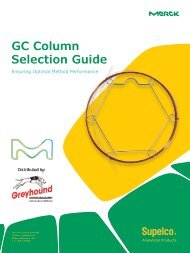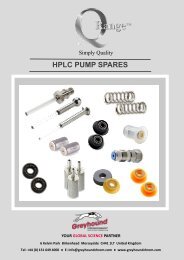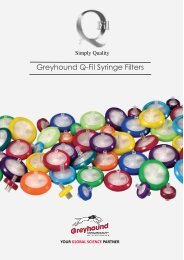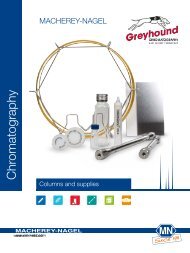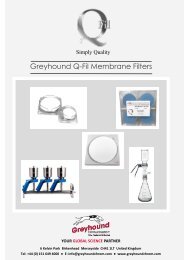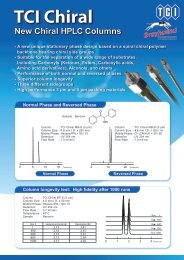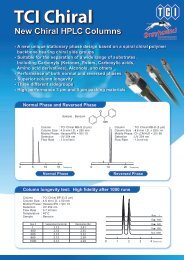You also want an ePaper? Increase the reach of your titles
YUMPU automatically turns print PDFs into web optimized ePapers that Google loves.
SYRINGE TECHNICAL REFERENCE | FREQUENTLY ASKED QUESTIONS<br />
Needle Questions<br />
10<br />
How do I find a needle<br />
for my syringe?<br />
13<br />
Does <strong>Hamilton</strong> offer<br />
a needle sheath?<br />
11<br />
Use the tutorial on page 9 to determine what<br />
needles are compatible with your syringe. Then<br />
turn to the Needles section to find a part number.<br />
Is the needle dead volume<br />
part of the total volume of<br />
the dispensed fluid?<br />
No, the liquid in the needle is not part of the dispense<br />
volume. The needle contains a constant dead volume<br />
throughout the aspirate and dispense steps.<br />
When performing a GC injection one thing to consider<br />
is that the sample is aspirated at room temperature.<br />
When the sample is dispensed the needle starts to<br />
warm up to the temperature of the GC inlet. If the<br />
sample trapped in the needle is volatile it may begin<br />
to expand and result in the introduction of additional<br />
sample into the GC. To minimize this effect it is critical<br />
that the injection timing is the same for all injections.<br />
14<br />
No, <strong>Hamilton</strong> does not offer a needle sheath.<br />
Our syringes are not for human use, and our<br />
needles do not come with a medical point.<br />
If a sheath is required it is possible to buy a<br />
third party Luer Lock needle and attach it to<br />
a <strong>Hamilton</strong> Luer Tip or Luer Lock syringe.<br />
Can disposable needles work<br />
with <strong>Hamilton</strong> syringes?<br />
Yes, our Luer Tip (LT) and PTFE Luer Lock (TLL)<br />
syringes can accept most industry standard<br />
disposable luer lock needles.<br />
12<br />
What does the “s” mean in<br />
a 22s or 26s gauge needle?<br />
For needles the gauge indicates the outer diameter<br />
of the needle tubing. The difference between a 26<br />
gauge needle and a 26s gauge needle is the<br />
thickness of the tubing wall. The “s” needles have a<br />
thicker wall which results in a more rigid needle and<br />
a smaller dead volume. Smaller dead volume needles<br />
come standard on small volume syringes to make<br />
them practical to prime.<br />
A table of available needle gauges and their<br />
dimensions can be found on page 119.<br />
88





